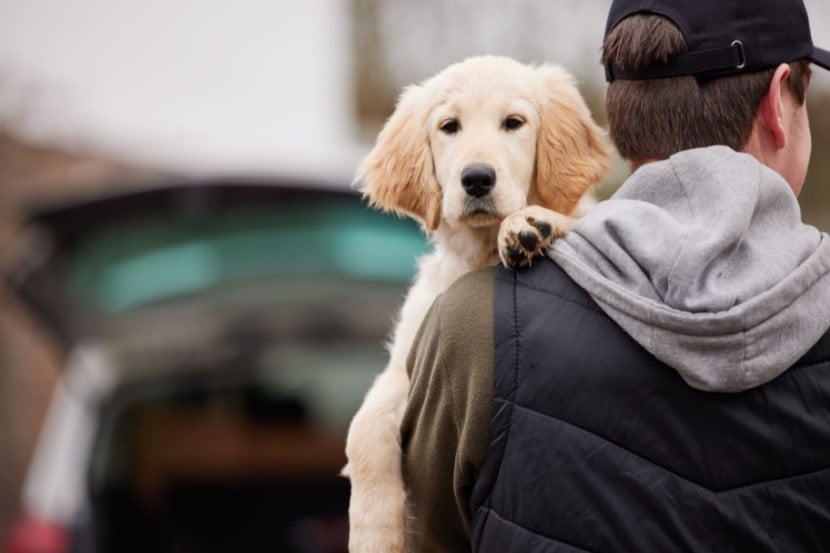Dogs are highly attractive to thieves and there’s quite a lucrative business in trading stolen pooches. Here we explain how you can stop your best friend from being stolen.

Top tips to reduce your risk of dog theft
1. Invest in a GPS tracking collar
A GPS tracking device such as an Apple Tag lets you know where your dog is at all times. This should help should they go missing or wander off.
2. Don’t put your dog’s name on a collar or tag
This makes it easier for a thief to call them over. Don’t highlight your dog online, particularly on social media. You should put your name and contact details on the collar in case someone finds your dog.
3. Avoid routine
If you have a breed that's a high-risk target, don’t walk the same route at the same time of day. This could make it easy for a thief to learn your habits and know when and where to steal your dog.
4. Walk with a friend
If possible, dog walk with a friend or group of friends. There's safety in numbers.
5. Encourage your dog to respond to your voice
Practice recall so they don’t go bounding off at the park. This way if you suspect someone of having ill intentions you can retrieve your pet and leave. If your dog isn’t up for learning new tricks, such as returning to you, put them on an extended lead when in wide open spaces. This lets them exercise with reduced threat of being taken.
6. Be extra vigilant
Avoid dark and secluded areas, keep aware of your surroundings and anyone in your vicinity. If you feel uncomfortable, head for a populated area, or a shop. Trust your instincts.
7. Use trustworthy dog services
If you plan to use a dog walker, kennel or grooming service check them out – get references and search for reviews.
8. Beware of keeping your pet in your car
Avoid leaving your dog alone in your car where possible, especially in hot weather. If you must, leave a gap in the window so they can breathe, but ensure the car is locked.
9. Don’t leave your dog unattended in the front garden
Don’t leave your dog in the care of a child either, as a criminal might not think twice about going through them to get at your dog.
10. Secure your dog outside
If you keep your dog in a outside kennel ensure it’s locked and alarmed.
11. Think about garden security
Invest in robust locks for your garden gates. If you’ve got a secluded garden, and there’s an access point someone could exploit, think about raising the height of the fence to 6 feet. Also, consider laying gravel on paths as this might deter would-be thieves.
12. Get your dog microchipped
Microchipping is a legal requirement for all dogs in the UK before they reach 8 weeks old. It's relatively cheap and should be painless for the dog.
The rise of dog theft
Dog theft is on the rise. More than 1,880 dogs were stolen in 2021 alone - 25% more than in the previous year, according to Pet Theft Reform. The pandemic didn’t help matters as dog walking was one of the few exercises in which we could participate.
The tragedy of dog theft is that, unlike a stolen watch or a bicycle that can be replaced, a dog is part of the family and its loss affects all. The problem is dogs are valued by crooks as well as homeowners, and certain breeds hold more weight with the criminal community than others.
The most stolen dog breeds in the UK
According to Pets4Homes, the most stolen dog breeds in the UK are:
-
Why are dogs stolen?
- Review their habits and behaviours
- Think again about how they can ensure their beloved pet is safe
The main reason dogs are stolen is for a cash reward. Whether that's knowing the dog's family will offer a sizeable reward for the dogs safe return, or through selling the dog on.
Purebred dogs that are high in demand, such as labradoodles, are most likely to be stolen as thieves can make quick cash. Dog thieves typically sell the dogs for half the price of a legitimate breeder.
Stolen dogs can also be sold to puppy mills for breeding purposes, which is why it's important to spay or neuter your dog.
Some may also even steal your dog to be used as 'bait dogs' where they are trained to fight. Dog breeds such as Pit Bull Terriers, German Shepherds and Dobermans fall most victim to this.
What are the worst areas for dog theft?
According to a 2020 report from CrimeRate, these are the top 10 police force areas for dog theft in England:
| Police Force | Dog thefts per 100k people |
|---|---|
|
Metropolitan Police
|
45.0787
|
|
Kent
|
33.3653
|
|
Cleveland
|
24.6475
|
|
West Yorkshire
|
23.3868
|
|
Cambridgeshire
|
21.4721
|
|
Humberside
|
21.2388
|
|
Northumbria
|
18.8225
|
|
Derbyshire
|
14.8427
|
|
Dorset
|
14.5455
|
|
Suffolk
|
13.8985
|
Visit CrimeRate for the full list.
Dog theft urban myths
It’s tempting to get too hung up on dog theft. But it’s important to differentiate between genuinely suspicious behaviour and urban myths.
Cable ties
Take the cable ties dog theft rumours. These circulated a year or so back, and have gone viral. The premise is that groups of dog snatchers identify homes where there’s a valuable pup or dog and flag this up to their fellow crooks by applying a cable tie around the nearest lamp post. While some people do indeed put cable ties around posts, there’s no proof that this is at all linked with dog theft.
Dog theft markings
Rumours have abounded for years that burglars and thieves leave hieroglyphs in the form of white chalk markings to indicate a potentially lucrative target. Strange chalk squiggles are said to be used to show when homeowners are on holiday or if they leave a prized pet unguarded while out to work.
Again, there’s little if any evidence that this is anything other than an urban myth. But there’s no harm in removing those cable ties or scrubbing out chalk marks if you see them.
What to do if your dog is stolen
If your dog goes missing don’t be shy about reporting it. More than 1,800 dogs were reported stolen in 2021, so it’s far from a rare event. According to Crimestoppers, the best course of action is to report a suspected theft to the police. You should be given a crime reference number, which you need to keep safe.
The police need an accurate description of your pet, and ideally a recent photo. Also think about your dog’s temperament. Is it yappy, excitable, quiet? If it’s been tagged, pass on the relevant information and update the microchip database.
Also contact your local council, as they might have a dog warden service that picks up strays. There’s always a chance that your hairy friend just went walkabouts, rather than being stolen. It’s also worth printing up some photos and posting them in newsagent windows, on lampposts, in the free local press and on sites such as the National Pet Register and DogLost.
Pet theft awareness day
On 14 February it's not only Valentine’s Day -since 1988 it’s also become Pet Theft Awareness Day. The aim of the day is to spread the word about the dangers of pet theft. Dog theft in particular is a serious issue and the point of Pet Theft Awareness Day is to encourage pet owners to:
The campaign offers advice on how to improve your security, and what to do if the worse happens and your pet is stolen. Its website features template letters you can use to write to people in authority to prompt them to take pet theft more seriously and penalise more toughly those who steal pets.
Does my pet insurance policy cover dog theft?
Yes, some pet insurance policies let you claim for missing or stolen pets, up to a certain amount. Most dog insurance policies cover you for the costs of advertising a missing pet, as well as a reward for their return.
Your pet insurance provider should also be able to give you advice on what to do if your pet goes missing or is stolen.
The specific amount you're covered for depends on the policy and the value of your dog, so check with your insurance company first.







